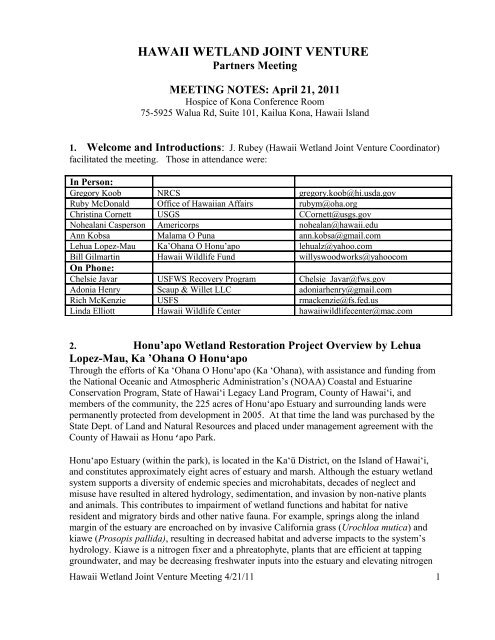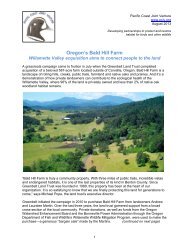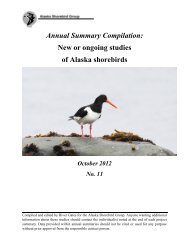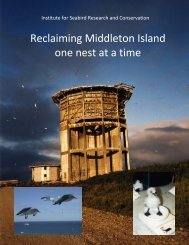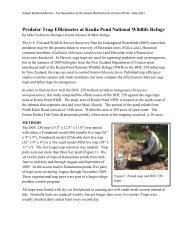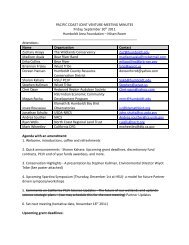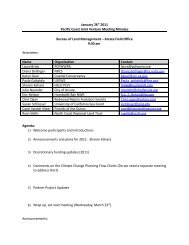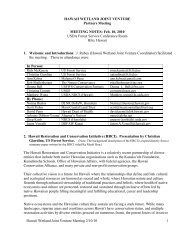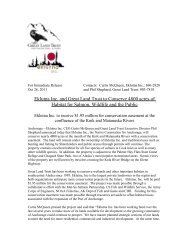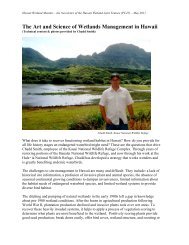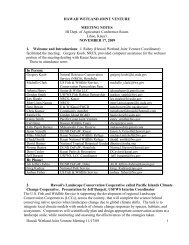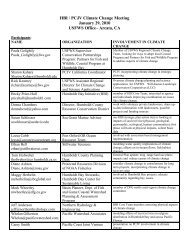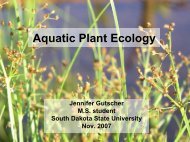hawaii wetland joint venture - Pacific Coast Joint Venture
hawaii wetland joint venture - Pacific Coast Joint Venture
hawaii wetland joint venture - Pacific Coast Joint Venture
Create successful ePaper yourself
Turn your PDF publications into a flip-book with our unique Google optimized e-Paper software.
HAWAII WETLAND JOINT VENTURE<br />
Partners Meeting<br />
MEETING NOTES: April 21, 2011<br />
Hospice of Kona Conference Room<br />
75-5925 Walua Rd, Suite 101, Kailua Kona, Hawaii Island<br />
1. Welcome and Introductions: J. Rubey (Hawaii Wetland <strong>Joint</strong> <strong>Venture</strong> Coordinator)<br />
facilitated the meeting. Those in attendance were:<br />
In Person:<br />
Gregory Koob NRCS gregory.koob@hi.usda.gov<br />
Ruby McDonald Office of Hawaiian Affairs rubym@oha.org<br />
Christina Cornett USGS CCornett@usgs.gov<br />
Nohealani Casperson Americorps nohealan@<strong>hawaii</strong>.edu<br />
Ann Kobsa Malama O Puna ann.kobsa@gmail.com<br />
Lehua Lopez-Mau Ka’Ohana O Honu’apo lehualz@yahoo.com<br />
Bill Gilmartin Hawaii Wildlife Fund willyswoodworks@yahoocom<br />
On Phone:<br />
Chelsie Javar USFWS Recovery Program Chelsie_Javar@fws.gov<br />
Adonia Henry Scaup & Willet LLC adoniarhenry@gmail.com<br />
Rich McKenzie USFS rmackenzie@fs.fed.us<br />
Linda Elliott Hawaii Wildlife Center <strong>hawaii</strong>wildlifecenter@mac.com<br />
2. Honu’apo Wetland Restoration Project Overview by Lehua<br />
Lopez-Mau, Ka ’Ohana O Honuʻapo<br />
Through the efforts of Ka ‘Ohana O Honu‘apo (Ka ‘Ohana), with assistance and funding from<br />
the National Oceanic and Atmospheric Administration’s (NOAA) <strong>Coast</strong>al and Estuarine<br />
Conservation Program, State of Hawai‘i Legacy Land Program, County of Hawai‘i, and<br />
members of the community, the 225 acres of Honu‘apo Estuary and surrounding lands were<br />
permanently protected from development in 2005. At that time the land was purchased by the<br />
State Dept. of Land and Natural Resources and placed under management agreement with the<br />
County of Hawaii as Honuʻapo Park.<br />
Honu‘apo Estuary (within the park), is located in the Ka‘ū District, on the Island of Hawai‘i,<br />
and constitutes approximately eight acres of estuary and marsh. Although the estuary <strong>wetland</strong><br />
system supports a diversity of endemic species and microhabitats, decades of neglect and<br />
misuse have resulted in altered hydrology, sedimentation, and invasion by non-native plants<br />
and animals. This contributes to impairment of <strong>wetland</strong> functions and habitat for native<br />
resident and migratory birds and other native fauna. For example, springs along the inland<br />
margin of the estuary are encroached on by invasive California grass (Urochloa mutica) and<br />
kiawe (Prosopis pallida), resulting in decreased habitat and adverse impacts to the system’s<br />
hydrology. Kiawe is a nitrogen fixer and a phreatophyte, plants that are efficient at tapping<br />
groundwater, and may be decreasing freshwater inputs into the estuary and elevating nitrogen<br />
Hawaii Wetland <strong>Joint</strong> <strong>Venture</strong> Meeting 4/21/11 1
levels. Previous studies of the estuary and surrounding area indicate that native species,<br />
including birds listed as endangered or species of concern, are present in the area. Although the<br />
system shows signs of degradation, management actions can be employed to help enhance<br />
habitat for native flora and fauna and to restore sections that have been filled or irreversibly<br />
altered. Enhancement and restoration actions are expected to increase habitat and improve<br />
<strong>wetland</strong> function.<br />
A Wetland Habitat Restoration Plan for Honu‘apo Estuary (WHRP), prepared by Sustainable<br />
Resources Group International Inc., is nearing completion and will provide guidance for a<br />
<strong>wetland</strong> restoration project that will restore the aquatic functions of the estuary through<br />
removal of invasive non-native plants; excavation of fill and contouring the topography to<br />
enhance physical habitat; planting native and endemic plants; and controlling predation on<br />
avian species. These actions are expected to improve habitat for native waterbirds, fish, and<br />
turtles and enhance other <strong>wetland</strong> functions. The WHRP is part of a Resource Management<br />
Plan that has been developed/adopted for Honu‘apo Park that provides land use guidance to<br />
help protect and restore the important natural and cultural resources of the property while<br />
providing integrated and respectful recreation and education opportunities for the Ka‘ū<br />
community and visitors.<br />
Ka ‘Ohana’s mission is to restore, care for, and protect the cultural and natural resources within<br />
the Honu‘apo area, working in partnership with Hawaii County Division of Parks and<br />
Recreation. The area containing Honu‘apo Park has played an integral role in Ka‘ū’s<br />
community life for many generations. Historically the area was a fishing village called<br />
Honu‘apo Village. The large estuary at Honu‘apo was used as a fishpond. Freshwater springs<br />
discharging into the estuary provided water for the residents of the village. Part of this place<br />
was also said to have had a well-known pu‘uhonua, a place of refuge.<br />
Ka ‘Ohana secured funding from the State of Hawai‘i <strong>Coast</strong>al Zone Management (CZM)<br />
Program (through County of Hawai‘i Department of Planning), the U.S. Fish and Wildlife<br />
Service (USFWS), the <strong>Pacific</strong> <strong>Coast</strong> <strong>Joint</strong> <strong>Venture</strong> (PCJV), and private sources to develop the<br />
WHRP. The next steps will be to seek financial assistance to implement the <strong>wetland</strong><br />
restoration plan.<br />
3. HWJV Coordinator’s Update by J. Rubey<br />
NEW Wetlands Brochure. DOFAW’s new Wetland Brochure and Poster, funded by the PCJV,<br />
were passed out. It is the first <strong>wetland</strong>s information material available for the general public of<br />
Hawaii. The brochure and poster can be accessed on the PCJV website at:<br />
www.pcjv.org/<strong>hawaii</strong>/<strong>wetland</strong>s Copies of the poster can be obtained directly from DOFAW’s<br />
Michelle Jones at Michelle.G.Jones@<strong>hawaii</strong>.gov<br />
PCJV Board Meeting & Discretionary Fund Projects. The PCJV Board just met in early April for<br />
their regular semi-annual meeting. A topic of discussion was the federal budget delays and making<br />
decisions regarding the PCJV discretionary fund projects. Since funding levels are unknown, the<br />
Board decided to designate potential funding level thresholds where projects within these levels are<br />
Hawaii Wetland <strong>Joint</strong> <strong>Venture</strong> Meeting 4/21/11 2
tentatively approved. It was explained that Hawaii’s discretionary fund projects this year were<br />
determined by the HWJV Executive Steering Team based on the national evaluation performance<br />
matrix for <strong>Joint</strong> <strong>Venture</strong>s and the Team’s interest in improving the capacity of our HWJV.<br />
Therefore projects submitted this year build on the biological planning capacity of our JV.<br />
Funding Reminders: a) North American Wetland Conservation Act Standard Grant round in early<br />
March and early August. The small grants ($75K max.) proposals are annual and due the end of<br />
October. c) National <strong>Coast</strong>al Wetlands Grant proposals are due the end of June, with drafts in May.<br />
Contact Norma Creps, DOFAW, with project proposals. We hope to propose Honu’apo for<br />
funding this year.<br />
2011 Wetlands and Waterbird Workshop: A draft “Save the Date” notice was shared for the<br />
upcoming Wetland and Waterbird Workshop this fall. The event will take place October 4-6 th at<br />
the Koolau Golf Course conference rooms in Kaneohe, Oahu. The workshop will provide hands-on<br />
afternoon training sessions for managers along with conference format presentations in the morning.<br />
Workshop presenters will be Andy Engilis, Jr. on the koloa hybrid identification key, Mike Reed<br />
with new software for managing endangered species in Hawaii, and Leigh Frederickson on the new<br />
Hawaii Wetland Management Handbook. Adonia Henry, founder of Scaup & Willet LLC is<br />
coordinating the event. Funds are provided by the PCJV and the NRCS. The Hawaii Chapter of the<br />
Wildlife Society is the host. A formal announcement will be distributed shortly and posted to the<br />
PCJV website at www.pcjv.org/<strong>hawaii</strong>.<br />
4. HWJV Partners’ Reports:<br />
• Mana Plain Wetlands: Adonia Henry shared that work is progressing successfully with<br />
the new hydrologist for the Mana Plain <strong>wetland</strong>s restoration water needs and site design.<br />
Also much work has been done at Kawaiele to reshape the ponds and remove invasive<br />
plants.<br />
• Hawaii Wildlife Fund: Bill Gilmartin has been working on the Wai’ ohinu <strong>Coast</strong>al<br />
Strand restoration on the southeast Kau coast. The area is Forest Reserve is a transfer to<br />
Division of Forestry and Wildlife from State Lands (still in process at the county level.) It<br />
is 1,350 acres and contains two anchialine ponds, one degraded with sediment and one<br />
with tilapia fish. The coastal strand is home to over three dozen indigenous and endemic<br />
plant species and is used by the Hawaiian monk seal and hawksbill turtle. Invasive plants<br />
are a major issue with Christmas berry a significant player. Restoration is being<br />
conducted over the next two years with Fish Habitat Partnership funding.<br />
• Office of Hawaiian Affairs: Ruby McDonald works on Section 106 compliance<br />
assistance here on Hawaii Island and provides finance assistance to Hawaiian natives.<br />
• USGS: Christine Cornett overviewed her continuing work with nene on Hawaii Island.<br />
She has been monitoring 7 nene with solar powered transmitters for one year now finding<br />
their roosting and summer locations. She says, “Nene really like water!” Making water a<br />
good predictor for finding them. So, high elevation stock ponds are being used. She says<br />
Hawaii Wetland <strong>Joint</strong> <strong>Venture</strong> Meeting 4/21/11 3
they used to breed in lowland areas but don’t now due to predators and humans. She<br />
would expect that they would use Honu’apo with protections from predators and humans.<br />
• NRCS: Greg Koob shared that the NRCS has released a new landowner brochure on nene:<br />
“Nene & Hawaiian Farmers.” The brochure advertises financial and technical assistance<br />
provided by the NRCS to landowners experiencing nene crop loss. This assistance is<br />
available through the EQIP & WHIP programs to landowners on the Big Island and Kauai.<br />
To view the brochure go to: ftp://ftpfc.sc.egov.usda.gov/HI/pub/technical/biology/nene_brochure.pdf<br />
or<br />
http://www.pia.nrcs.usda.gov/technical/biology.html. Additional information can be<br />
obtained at any local NRCS field office.<br />
5. Mangrove Removal at Wai ‘Opae & Alula Bay by Ann Kobsa, Malama O<br />
Puna<br />
Ann provided an overview of the restoration of coral pool and reef ecosystem invaded by alien<br />
red mangrove (Rhizophora mangle) that was conducted at WaiʻOpae during 2009. Here in<br />
Hawaii the non-native mangroves grow to higher densities and shed more biomass than in their<br />
native range, thus negatively impacting fish and reef ecosystems as well as the native land<br />
vegetation. At the start of the project red mangrove was overtaking the rare native coastal<br />
forest and coastal plants at Wai ‘Opae. The area had about 20 acres of mangroves covering an<br />
extensive network of tidal pools and ranging from dense mangrove swamp with trees up to 80<br />
ft tall, to mangrove thicket from 3 to 20 ft. tall, to sparse mangrove keiki colonizing bare<br />
pahoehoe. However after injection of the mangroves with Habitat (imazapyr) and with<br />
assistance from volunteers to pull out young keiki the situation began to reverse. Soon<br />
extensive die off of the mangroves occurred. In the interior of Wai ‘Opae dead mangroves<br />
were replaced by a natural growth of interspersed milo trees and new milo seedlings. In<br />
addition, replanting of hala, milo and naupaka were conducted and already the native coastal<br />
vegetation is beginning to rebound and reclaim its previous home.<br />
Wai ‘Opae is the largest of the hand full of sites invaded by red mangroves on Hawaii Island.<br />
The other smaller sites, mostly on the Hilo side of the island, have since been treated. Thus<br />
very little invasive red mangrove is left before full removal of this species occurs on Hawaii<br />
island. The next project site will be the small one acre at Alula Bay, on the west side, where a<br />
thick grove of mangrove is taking over the rare anchialine ponds and digging into an ancient<br />
heiau structure. Here Malama O Puna and the Big Island Invasive Species Council will be<br />
completing a manual removal of the mangrove and the underlying pickleweed that thickly<br />
blankets and chokes out native aquatic plants. Monitoring will be conducted, both pre and post<br />
removal to determine the effects to the aquatic environment. Also, comparisons will be made<br />
between use of the injection method at Wai ‘Opae and the manual approach at Alula Bay.<br />
Following this presentation Ann lead a Wetland Site Visit to Alula Bay to further discuss the<br />
issues and actions planned. Many thanks to Ann for traveling around the island to present this<br />
information!<br />
Hawaii Wetland <strong>Joint</strong> <strong>Venture</strong> Meeting 4/21/11 4


